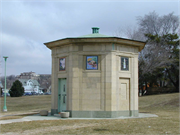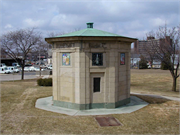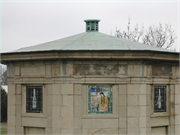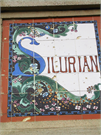| Additional Information: | A 'site file' exists for this property. It contains additional information such as correspondence, newspaper clippings, or historical information. It is a public record and may be viewed in person at the Wisconsin Historical Society, Division of Historic Preservation-Public History. The Silurian Mineral Spring House is a small, one story concrete block structure. The individual faces of the polygonal building feature recessed panels, framed by fluting and including mosaic panels depicting spring related motifs. A mosaic panel centered above the entrance contains the name of the spring, "Silurian." The walls of the structure terminate at a classical frieze, detailed with triglyphs and metopes, beneath the sectional roof. The copper roof of the structure was restored in 2003. The Silurian spring structure is a reminder of the springs era, but was actually constructed to cap the well rather than as an open, accessible spring house. The houses constructed during the height of the springs era ranged from open, gazebo-like buildings (for example, the Arcadian Springs pavilion and previous SIlurian springhouse - both razed), to classical designs (Hygia Springs - razed).
This reflects the spirit of the Classical mode and is architecturally significant as a type of buliding, and an example of a period of construction. Aesthetically, this is the most distinctive example of this type of structure remaining in the city; the majority of springs have been capped more recently with undecorated concrete block structures. The actual spring houses, which dotted Waukesha in the nineteenth century, have been razed, although ruins of two houses are reportedly located on the White Rock Mineral Spring property. A city park shelter is also located in the park but does not contribute to the significance of the nominated property.
The Silurian Park was Waukesha's second, large private park, in competition with the Bethesda Springs Park. The spring itself had been in use since 1840 when David Jackson bought the property for a homestead. Following the development of Bethesda Springs in 1868, the property was purchased by the Waukesha Mineral Spring Company. This spring was named Silurian after the prehistoric sea which had once covered the area. A large park was developed in concert with the bottling works. The property was located along Broadway where the Office and YMCA are now located and stretched north from the street to include all of the present Waukesha Springs Park. The Silurian Springs Park was developed over the years with gardens, landscaping, a bath house, walks and benches. At some point it also included an open air theater for concerts and stage productions. In 1893, the Silurian Casino was erected. Following the decline of the Springs Era, the park deteriorated and portions along Broadway were sold. The park was purchased for development shortly after the First World War, but plans never materialized. The bottling plant failed in the 1920s. In 1928, the new owner of the property erected the present Silurian springhouse on the site of the old pavilion. The springhouse and a large portion of the original Silurian Springs Park are now within Waukesha Springs Park, part of the City park system.
Although constructed at the end of the Springs era, the Silurian Springhouse is considered historically significant as a reminder of the importance of the springs to Waukesha, both economically and culturally. |
|---|
| Bibliographic References: | (A) Zimmerman, #738.
(B) Stone over doorway.
(C) Tallmadge, Edith, "Revival of Waukesha, The Saratoga of the West," unpub. 1953.
(D) Waukesha Freeman, Sept. 3, 1936. |
|---|





